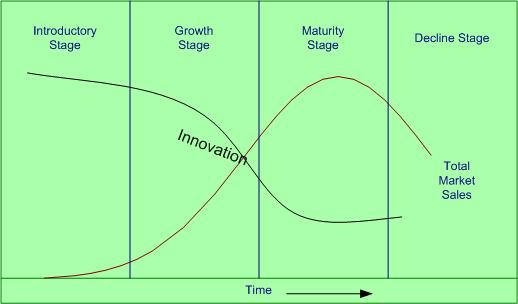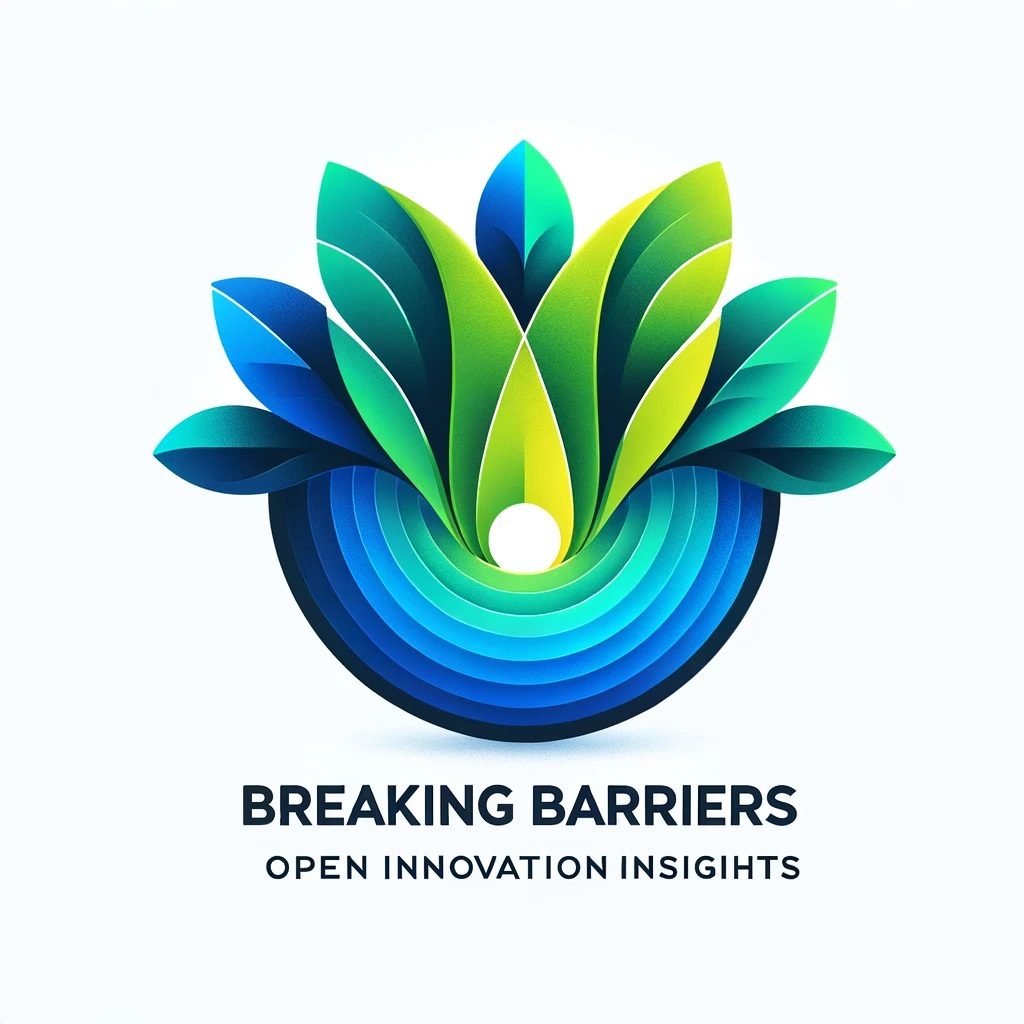In most organizations, innovation slowly diminishes as they move from early stages to maturity. This is primarily because as an organization grows and establishes itself in the market, the focus shifts more on efficient operations through process standardization and controls to enable predictability in operations and output. Over time this becomes a norm and innovation takes back seat until the organization is faced with negative external or internal challenges impacting its market position, bottom line, something that challenges its existence, faced with fading market share to the competition, and or other factors. When that happens focus shifts back to innovation but by then organizations are usually too far behind on innovation curve. Though it’s still possible to revive and be on a growth curve again, the damage is already done by then.
Following graph shows how innovation diminishes as the organization moves from early stages to maturity:
The CEOs are well aware that in a global economy and constantly diminishing product life cycles their organizations have to consistently innovate not just on products and services but also on everything that the organization does for sustainability. The creation of the chief innovation officer (CIO) position in few organizations shows that focus is shifting in the right direction. However many organizations still don’t have a clear strategy on how to promote a culture of innovation and empower their employees to take risks. The employees are also not allowed to challenge the status quo without any fear of negative consequences
To innovate in any organizational setting requires acknowledgment of new ideas, irrespective of the level and position in the organization of the originator. Along with that organizations should also establish a mechanism to absorb risks from new ideas, refrain from the standardization of processes until after incubation phase, be willing and open to the change, and challenging assumptions. This coupled with a lean organization and a mindset that innovation is the only way to build exponential organizations of the future is also required. Appreciation for innovation is further enabled when an organization deliberately tries to stay connected with the macroeconomics, sociological, political, demographic, technological trends all within the context of changing customer needs, competitors, suppliers, new entrants, substitutes, and or other unfavorable/favorable factors.
In the context of digital transformation as well, innovation is the only way forward. It’s a misnomer that for an organization to stay competitive it has to constantly come up with disruptive innovations at whatever cost- a term often misinterpreted. In today’s knowledge economy, organizations can often innovate economically by reconfiguring/rearranging knowledge resources and known small discrete solutions at low cost, often even free with open source solutions. It’s like building something new from available lego pieces – akin to the knowledge resources and available solutions. There is no need for a grand execution plan to innovate, something that organizations usually end up pursuing. To begin only a small investment in a learning plan with a manifesto to challenge every assumption organization has made consciously or unconsciously is needed. An organization with a learning plan integrated into its execution plan is far more innovative than just with an execution plan. A learning plan that integrates knowledge resources is the most effective way to inculcate a culture of innovation.
To enable an innate drive in employees towards innovation also requires support that empowers employees to try something different outside their regular job profile, experience, and skills. This is further fueled by strong evidence-based market predictions and an organization’s ability to overlap individual goals with that of organizational goals. That’s why it’s equally important to hire individuals who believe in organizations’ purpose, have a related story to share, or are motivated to create one with their new organization. Employees who support the subtle idea of innovation in any organization usually have an entrepreneurial mindset and are creative enough to execute on ideas without adversely impacting organizations’ current position.
Unfortunately, though innovation has become a common buzz word, it’s rare to find champions of innovative ideas in a corporate setting.
Any organization and at any level of maturity have the potential to innovate. But find it risky to empower employees to take their ideas forward because
- New ideas force people to think and do things differently from what they are used to and comfortable doing
- The corporate culture supports instant gratification and short term goals
- The long term goals are seen with skepticism
- Innovation brings in some level of disruption that’s rarely supported especially if that impacts an organization’s short-term goals
- The champions of new ideas have a very small window to prove themselves
- Whether an organization is a public or private entity – more resistance is usually expected in public undertakings
- Fear that new product line/services may cannibalize existing product lines/services
- Funding for new ideas has to come from somewhere and if it’s from within the organization then that means somebody has to take a cut – nobody likes that
- The market sees investment in something new as high risk. The shareholders usually don’t support that and liking is always for something that has been proven to be successful, has low risk, ensures stakeholders value, and doesn’t disrupt current year over year growth
- Organizations struggle with choosing an appropriate organizational structure to support innovative ideas
- In the early stages of execution, new opportunities will consistently show losses – this may affect the overall bottom line of an organization. No one likes that. In beginning new opportunities are always ugly among good, bad and ugly performers within an organization
- Absence of risk assessment and mitigation plan on existing products and services due to the changes in the industry and market structure, customers needs, sociological, political, legal, economic, and or technological
What can be done? besides being creative, an integral part of innovation –
- The organization, with its people at the core of it, should be willing to learn to unlearn. As human beings, we all can relate to what unlearning means. As an example, for the last few months, I have been searching for a guitar instructor and the first question I always ask whoever I have met so far is – Can you start by making me unlearn whatever I learned as a teenager about playing guitar? I picked on guitar on my own as an outlet after the loss of a very close friend. The first and only Hindi song I wrote, composed and sang stayed with me. I find it now limiting and a bottleneck whenever I try to play or create new music. Overtime whatever we practice becomes our habit. At the gist and also the first step for innovation is to break out of some of these habits by learning to unlearn. Though learning to learn should remain a good mantra for the sustainability of an organization but when it comes to innovation organization should develop a culture that provides new opportunity a fresh start and without any biases
- Though some elements will always be applicable, execution on the new opportunity shouldn’t be based entirely on experience from past opportunities. Experience from those opportunities is important but their application in entirety to new opportunities will surely kill innovation. That’s what most of the organizations end up doing because whatever is already known provides a sense of comfort and predictability. But data suggests from both failed and successful ventures that same result, as in the past, is not guaranteed just by copying “as-is” for success and avoiding whatever didn’t work
- Strong leadership support and conviction is also crucial especially in early stages because that’s when most resistance is expected from investors, stakeholders both within and outside the organization, employees or anybody else who is going to be directly or indirectly impacted
- Selection of organizational structure – The best approach to support new opportunities is to treat it as a startup with an independent entity and financial reporting. If that’s not possible then within an organization there should be a group responsible for collecting new ideas, conducting opportunity assessment, and then aligning resources to enable execution. When in execution, adoption of matured processes from other business units, for example on IPs, legal, R&D, sales & marketing, technology transfers, etc is always a good idea.
- If you are a senior leader in an organization, remember one thing that no good idea should end up in the trash or leave with individuals who came to you first for support with real conviction and evidence to support that idea has the potential to succeed. It’s not always easy to support all ideas but over time just by paying attention, you will build capabilities, confidence, and sometimes even intuition about success on new ideas. But above all it will make you more aware, connected, predict, and be able to gauge what next disruptive innovation can do to your business
- The source of funding –If treating it as a new entity then, the parent organization is an obvious first choice for funding but it probably would be in the best interest if funding comes from investors who don’t have a stake in the parent company or are willing to take a risk and invest in something new independent of their interests in the parent company
- If a new opportunity is executed within the current organization setting then funding for a new opportunity can come as a fraction of funding set aside for mitigation plans on overall risks to existing products and services from the competition; changes in customer needs; changes to legal, regulatory, political, economic, technological, or changes to the national business system, in general,
- As part of a new product/service development budget
- As part of the R&D budget
- The leadership – ideally new organization should have dedicated resources. If that’s not possible then individuals from parent company who understand and are willing to support the new idea with conviction should be appointed to lead
- Organization structure – a flat structure is ideal where decisions can be made faster
- Adopt lean startup mindset
More than ever now there is a need innovate to remain competitive, for economic growth, job creation, and for bringing us back on a solid path to recovery on a global platform. There are opportunities to innovate all around us, we just need to give it a try and be willing to execute with conviction. You can start with something small and simple, that’s all it takes to make it a culture

